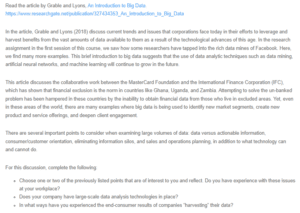Discussion – Big data
The greatest challenge that my colleagues and I faced at the organization I work had largely to do with information silos. Although the issue is slowly being resolved, there is still much to be done. The silos severely restrict the smooth flow of information and, consequently, subpar productivity results (Miller et al., 2010). For example, the research and development team is notorious when it comes to sharing information with the marketing department. The limited information that the former shares with the latter often causes the marketing team to make decisions that are, at times, inaccurate. This has, on more than one occasion, caused the organization to face backlashes from the end consumers, halted marketing campaigns midway, and not to mention stirred some bad blood. The situation like I mentioned, is still under ‘re-construction’ to better improve communication between the two departments.
The organization that I work with has moderately large-scale data analysis technologies in place. The company collects customer data based on their use of the organization’s website. The information is then utilized by the company to tailor products and services that are as close as possible to customer preferences. Grable and Lyons (2018) note that organizations use data from consumers to make corporate decisions. As an end consumer, I have experienced the results of company data in many ways, but I will only mention two. The first is at the mall that I frequent; the management has a system that allows the shops that I often visit to send me notifications on the latest offers, when the best time is with maximum parking space on the usual days that I visit, among others. The second is my mobile service subscription. The company uses my data on the internet, call, and text usage to create offers tailored for me and at off-peak hours. For example, during the weekends, when I have the most time to make calls, the company offers me low rates on international and local calls so that I can reach as many people as I can and at lower prices.
References
Grable, J. E., & Lyons, A. C. (2018). An Introduction to Big Data. Journal of financial service professionals, 72(5).
Miller, L. C., Jones, B. B., Graves, R. S., & Sievert, M. C. (2010). Merging silos: Collaborating for information literacy. The Journal of Continuing Education in Nursing, 41(6), 267-272.
ORDER A PLAGIARISM-FREE PAPER HERE
We’ll write everything from scratch
Question 
Read the article by Grable and Lyons, An Introduction to Big Data. https://www.researchgate.net/publication/327434353_An_Introduction_to_Big_Data
In the article, Grable and Lyons (2018) discuss current trends and issues that corporations face today in their efforts to leverage and harvest benefits from the vast amounts of data available to them as a result of the technological advances of this age. In the research assignment in the first session of this course, we saw how some researchers have tapped into the rich data mines of Facebook. Here, we find many more examples. This brief introduction to big data suggests that the use of data analytic techniques such as data mining, artificial neural networks, and machine learning will continue to grow in the future.

Big data
This article discusses the collaborative work between the MasterCard Foundation and the International Finance Corporation (IFC), which has shown that financial exclusion is the norm in countries like Ghana, Uganda, and Zambia. Attempting to solve the un-banked problem has been hampered in these countries by the inability to obtain financial data from those who live in excluded areas. Yet, even in these areas of the world, there are many examples where big data is being used to identify new market segments, create new product and service offerings, and deepen client engagement.
There are several important points to consider when examining large volumes of data: data versus actionable information, consumer/customer orientation, eliminating information silos, and sales and operations planning, in addition to what technology can and cannot do.
For this discussion, complete the following:
- Choose one or two of the previously listed points that are of interest to you and reflect. Do you have experience with these issues at your workplace?
- Does your company have large-scale data analysis technologies in place?
- In what ways have you experienced the end-consumer results of companies “harvesting” their data?
